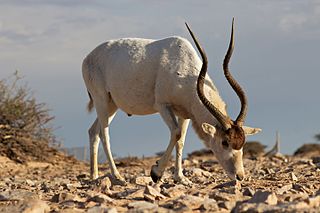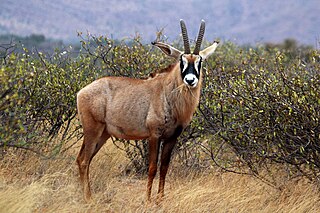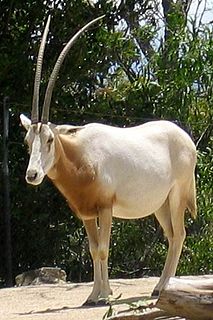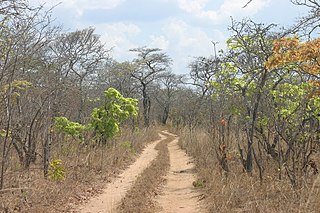
The term antelope is used to refer to many species of even-toed ruminant that are indigenous to various regions in Africa and Eurasia.

The Bovidae comprise the biological family of cloven-hoofed, ruminant mammals that includes cattle, bison, buffalo, antelopes, and goat-antelopes. A member of this family is called a bovid. With 143 extant species and 300 known extinct species, the family Bovidae consists of two major subfamilies and twelve major tribes. The family evolved 20 million years ago, in the early Miocene.

Oryx is a genus consisting of four large antelope species called oryxes. Their pelage is pale with contrasting dark markings in the face and on the legs, and their long horns are almost straight. The exception is the scimitar oryx, which lacks dark markings on the legs, only has faint dark markings on the head, has an ochre neck, and has horns that are clearly decurved.

The addax, also known as the white antelope and the screwhorn antelope, is an antelope native to the Sahara Desert. The only member of the genus Addax, it was first described scientifically by Henri de Blainville in 1816. As suggested by its alternative name, the pale antelope has long, twisted horns – typically 55 to 80 cm in females and 70 to 85 cm in males. Males stand from 105 to 115 cm at the shoulder, with females at 95 to 110 cm. They are sexually dimorphic, as the females are smaller than the males. The colour of the coat depends on the season – in the winter, it is greyish-brown with white hindquarters and legs, and long, brown hair on the head, neck, and shoulders; in the summer, the coat turns almost completely white or sandy blonde.

The roan antelope is a savanna antelope found in western, central, and southern Africa.

The sable antelope is an antelope which inhabits wooded savanna in East and Southern Africa, from the south of Kenya to South Africa, with a separate population in Angola.

The East African oryx, also known as the beisa is a species of antelope from East Africa. It has two subspecies: the common beisa oryx found in steppe and semidesert throughout the Horn of Africa and north of the Tana River, and the fringe-eared oryx south of the Tana River in southern Kenya and parts of Tanzania. In the past, some taxonomists considered it a subspecies of the gemsbok, but they are genetically distinct; the diploid chromosome count is 56 for the beisa and 58 for the gemsbok. The species is listed as Endangered by the IUCN.

The scimitar oryx, also known as the scimitar-horned oryx and the Sahara oryx, is a species of Oryx that was once widespread across North Africa. The species went extinct in the wild in 2000, but a group was released into an acclimation enclosure within the Ouadi Rimé-Ouadi Achim Faunal Reserve in 2016, then reintroduced back into the wild. An additional 21 animals were placed in the acclimation enclosure in 2017. In 2000, the species was declared extinct in the wild by the International Union for the Conservation of Nature (IUCN). The first ones to be relocated were released into the wild in 2016 and have adapted well to their surroundings. In 2017, another herd of 75 scimitar-horned oryxes arrived in an operation led by Chad's Ministry of Environment and Fisheries and the Sahara Conservation Fund. In 2021, 60 new calves were born, bringing the number in the wild to about 400. The species has not been assessed by the IUCN, though, since 2016, when the species was truly extinct in the wild, so it remains as extinct in the wild (EW). This particular oryx can survive for months or even years without drinking water. A grazing animal, it derives most of its daily moisture intake from plants.

The bluebuck or blue antelope is an extinct species of antelope that lived in South Africa until around 1800. It is congeneric with the roan antelope and sable antelope, but was smaller than either. It was sometimes considered a subspecies of the roan antelope, but a genetic study has confirmed it as a distinct species.

The Southern miombo woodlands is a tropical grasslands and woodlands ecoregion extending across portions of Malawi, Mozambique, Zambia, and Zimbabwe.










